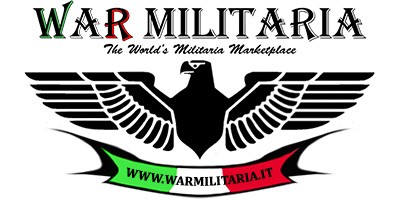No products
Product successfully added to your shopping cart
There are 0 items in your cart. There is 1 item in your cart.

Politic Badges
There are 77 products.-
Lower Saxony Braunschweig Day Badge
g483This badge was the official insignia for the Low Saxony meeting of 23-24th June 1934 held at Braunschweig.
16,90 € -
-
National Socialist Women’s League Badge
g413This was the badge worn by members of the NS Frauenschaft. On either side of the swastika respectively are the initials "G" and "H". At the bottom there is the letter "G". The letters on the pin (GHL) stand for the organization’s motto "Glaube, Hoffnung, Liebe" (Faith, Hope, Love).
16,90 € -
-
-
NSDAP Badge - District Section Meeting in Thuringia May...
g367Extremely rare badge originally made in cardboard.
12,90 € -
-
-
-
-
Nürnberg Rally Badge (Bronze)
g452bThis badge was awarded to Party members who attended the first-ever National NSDAP rally in the city of Nuremberg in 1929.
16,90 € -
Nürnberg Rally Badge (Silver)
g452aThis badge was awarded to Party members who attended the first-ever National NSDAP rally in the city of Nuremberg in 1929.
16,90 € -
RAD Badge for the Labour Service Exhibition in Breslau 1934
g478RAD badge given to the participants of the Breslau Exhibition in 1934.
16,90 € -
RADwJ Badge
g421aThe Reichsarbeitsdienst (abbreviated RAD) was a major organisation established by Nazi Germany as an agency to help mitigate the effects of mass unemployment on German economy, militarise the workforce and indoctrinate it with Nazi ideology.
16,90 € -
RADwJ Badge (Gold)
g421The Reichsarbeitsdienst (abbreviated RAD) was a major organisation established by Nazi Germany as an agency to help mitigate the effects of mass unemployment on German economy, militarise the workforce and indoctrinate it with Nazi ideology.
16,90 € -
Reich's Animal Protection Association Badge
g489With the seizure of power by the National Socialists, the Reich Bull Protection Act passed on November 24, 1933. Animal protection was partly founded by politically involed personalities and so it used to have anti-Semitic and biological traits, which led to an ideological association, now known as the "Reich's Animal Protection Association".
12,90 € -
Reichsparteitag Nürnberg 1933 Badge
g328aThe National Socialist German Workers' Party, commonly referred to in English as the Nazi Party, was a far-right political party in Germany that was active between 1920 and 1945 and practised the ideology of Nazism. Its precursor, the German Workers' Party (Deutsche Arbeiterpartei; DAP), existed from 1919 to 1920.
16,90 € -
Reichsparteitag Nürnberg 1933 Badge (Bronze)
g328bThe National Socialist German Workers' Party, commonly referred to in English as the Nazi Party, was a far-right political party in Germany that was active between 1920 and 1945 and practised the ideology of Nazism. Its precursor, the German Workers' Party (Deutsche Arbeiterpartei; DAP), existed from 1919 to 1920.
16,90 € -
SS Badge
g310The Waffen-SS (German pronunciation: [ˈvafən.ɛs.ɛs], Armed SS) was the armed wing of the Nazi Party's SS organisation. Its formations included men from Nazi Germany, along with volunteers and conscripts from both occupied and un-occupied lands.
12,90 € -
SS Badge
g26The National Socialist German Workers' Party, commonly referred to in English as the Nazi Party, was a far-right political party in Germany that was active between 1920 and 1945 and practised the ideology of Nazism. Its precursor, the German Workers' Party (Deutsche Arbeiterpartei; DAP), existed from 1919 to 1920.
12,90 € -
SS Badge (Bronze)
g26bThe National Socialist German Workers' Party, commonly referred to in English as the Nazi Party, was a far-right political party in Germany that was active between 1920 and 1945 and practised the ideology of Nazism. Its precursor, the German Workers' Party (Deutsche Arbeiterpartei; DAP), existed from 1919 to 1920.
12,90 € -
SS Badge (Chest)
g253The Waffen-SS (German pronunciation: [ˈvafən.ɛs.ɛs], Armed SS) was the armed wing of the Nazi Party's SS organisation. Its formations included men from Nazi Germany, along with volunteers and conscripts from both occupied and un-occupied lands.
16,90 € -
SS Badge (Eagle)
g113The Sturmabteilung (SA; German pronunciation: [ˈʃtʊɐ̯mʔapˌtaɪlʊŋ]), literally Storm Detachment, functioned as the original paramilitary wing of the Nazi Party (NSDAP).
12,90 € -
SS Gautag Munchen 1933
g428This rare badge commemorates the meeting of the Waffen SS in Munchen, in 1933.
16,90 € -
SS Gruppe-West Abschnitt XI Frankfurt am Main Rally badge
g484This badge was given for an SS event of June of 1933.
16,90 € -
-
Stadt des KdF-Wagens bei Fallersleben Badge
g394The Stadt des KdF-Wagens bei Fallersleben, a planned town centered around the village of Fallersleben, was constructed to be the home of the new Volkswagen factory.
12,90 € -
-
Volkswagen Badge (Silver)
g411aCommemorative badge for the birth of Volkswagen factory in Mai 1938.
12,90 €

